Climalytic Offers New Rain Gauge Design for Observers
Even the simple rain gauge evolves. This new CoCoRaHS-approved rain gauge is worth a look.
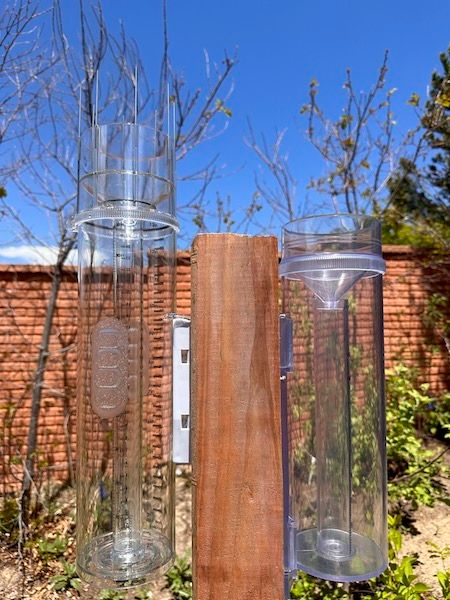
Climalytic, a small family-owned company in Colorado, is now offering a uniquely designed rain gauge for amateur meteorologists and observers. Called the Tropo, the gauge recently received approval from the Community Collaborative Rain, Hail, and Snow Network (CoCoRaHS) for use by their observers. For this review, we will use the standard CoCoRaHS 4-inch Stratus rain gauge for comparison.
| Spec | Tropo | Stratus |
|---|---|---|
| Height | 18.19” | 14” |
| Capacity (liquid) | 13.5” | 11” |
| Weight (lbs) | 1.68 | 1.25 |
| Funnel Height | 4” | 2.25” |
| Inner Tube | 14” | 10.5” |
| Inner Tube Dia. | 1.25 | 1.5 |
| Outer Tube Ht. | 14.75” | 12.25” |
Both the Tropo and the Stratus gauges are manufactured of polycarbonate plastic that is resistant to impact and UV damage and during my five years of experience with the Stratus I have observed no discoloration or clouding of the gauge. I expect the same with the Tropo. Observers can expect at least ten years life expectancy from both.
The Tropo was ordered directly from Climalytic and arrived well-packaged and with all components and hardware included:
• Handle
• Universal Mounting Bracket
• Bird Deterrent Rods (x8)
• Cap/Funnel
• Inner Tube (with dual unit increments)
• Outer Tube (with dual unit increments)
• Cable Ties (x2)
• Wood Screws (x2)
• Adhesive Strip
• Extra Long Cleaning Brush
• Bubble Level
• Installation Guide
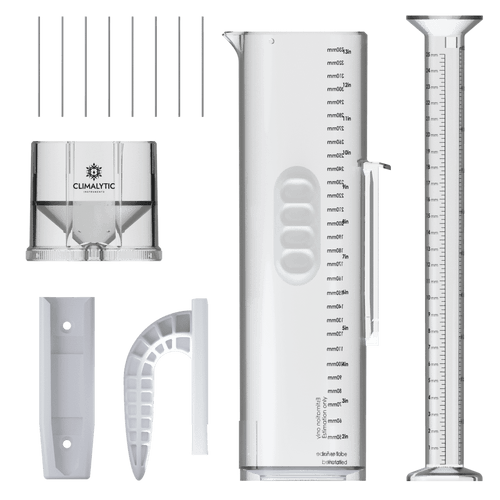
The mounting system is designed for easy installation and removal of the gauge in all conditions, especially freezing weather, a sore point with some Stratus users. When the gauge is removed from the mount, the carry handle can be attached to the mounting point on the outer tube for easy carrying, an important and welcome feature for those who live in rainy areas in the northwest and southeast where rain is sometimes measured in tens of inches.
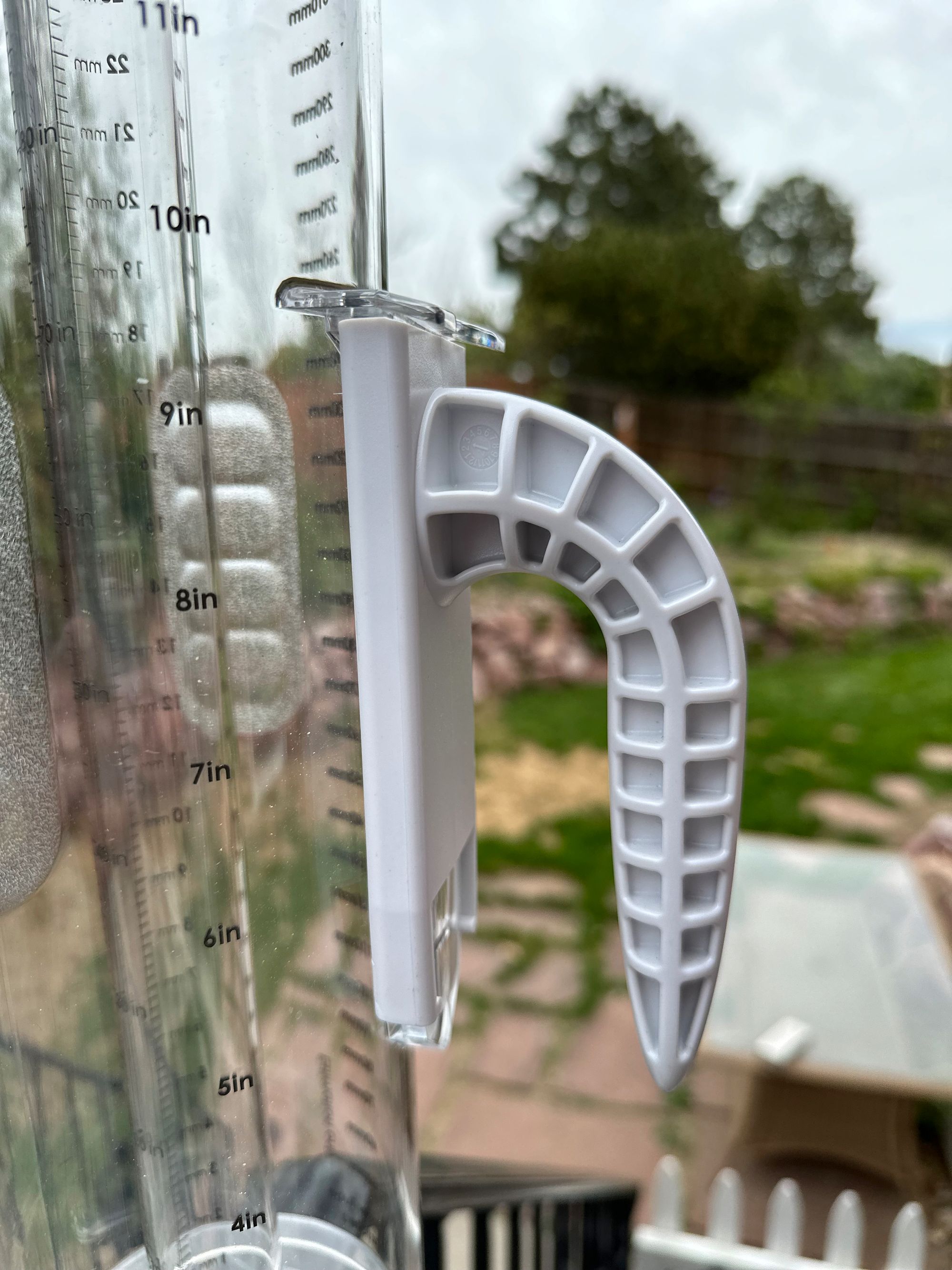
The Tropo also includes an adhesive rubber non-slip mounting pad that can be placed at the mounting point on a steel pipe to keep the rain gauge from sliding down the pole. Two heavy-duty tie wraps are included for fastening the mounting plate to the pole. Climalytics also helpfully includes a small level to ensure the gauge isn’t canted when you mount it.
I encountered a problem with the mounting system while tightening the screw at the top of the mounting plate. Because the back of the plate is curved to accommodate installation on a 1.25” pole or pipe, the plate cracked when I accidentally overtightened the screw. Backing the screw off a bit allowed the two parts to resume their shape, but I’ll eventually have to replace the plate. Just something to be aware of when mounting the gauge. [Note: the manufacturer says the cracking possibility will be emphasized in future documentation.]
Outer Tube
Both the Stratus and the Tropo share the same 4-inch diameter outer tube, with the Tropo standing 4” inches taller, giving it a capacity advantage of 2.5 inches of rain over the Stratus, again a bonus in areas that experience torrential downpours. The outer container has a pour spout to ease transfer of rain in excess of one inch back into the inner tube for measuring. There was some concern that the spout would bias snow core measurements by adding snow to a core collected when turning the outer tube upside down and pressing it into the snow. CoCoRaHS decided the small addition was insignificant and the manufacturer suggests placing tape over the spout if the small difference is a concern. Personally, I won’t bother.
Nice additions to the Tropo are the non-slip finger grips molded into each side of the outer tube, allowing a better grip while removing and replacing the rain gauge on its mount. This is a blessing for anyone who has ever dropped a rain gauge and lost 24-hours worth of data. Big hands also help.
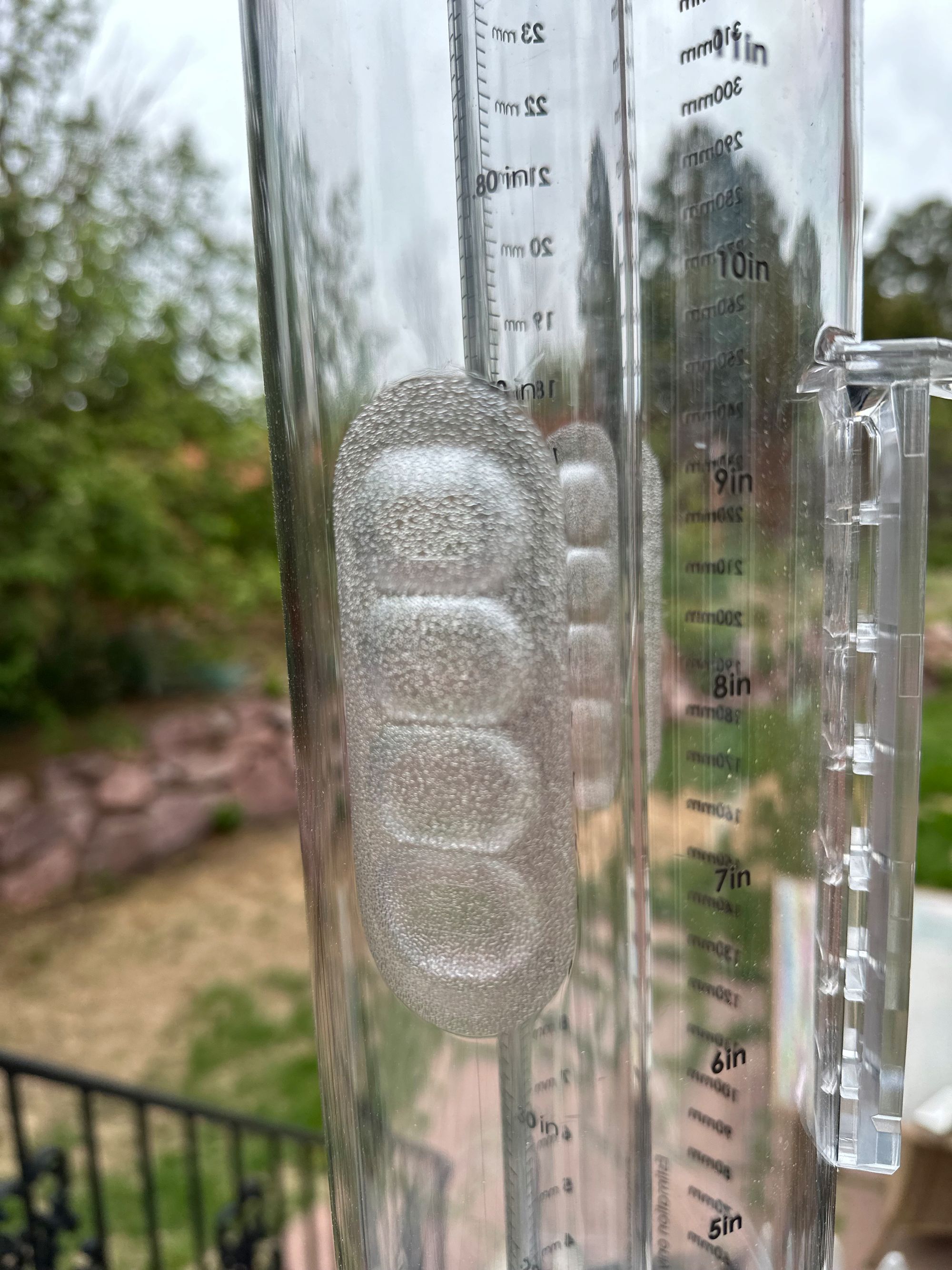
For estimation purposes, the outer tube is engraved with two scales in inches and millimeters. These scales are only valid with the inner tube installed
Inner Tube
Most precipitation measurements are under an inch and it is here that the Tropo rain gauge shines. The Tropo’s inner tube is 3.5” longer that the Stratus’ inner tube. Both tubes measure one inch of rain, so stretching that inch farther in the Tropo’s tube make it much easier to read the scale precisely when trying to determine exactly where the water column’s meniscus is. Like the outer tube, the inner is marked in 0.1-inch and 0.2-millimeter increments. The top of the inner tube, like the Stratus, has an overflow notch allowing rainfall in excess of one inch to flow into the outer tube. By attaching the included handle to the mounting point, it becomes easy to empty the inner tube and refill it with the overflow in the outer tube.
Spillage when transferring water from the outer to the inner tubes is prevented by the generous flare at the top of the inner tube. Another flare at the bottom of the tube adds stability when placing the inner tube into the outer and replacing the funnel. The Stratus has no flare at either end and requires more care when handling and replacing the top funnel. One caveat. The flare at the top and bottom of the Tropo’s inner tube are superficially similar enough that on at least two occasions I couldn’t get the funnel to seat until I realized the inner tube was upside down. What can I say, it was early in the morning.
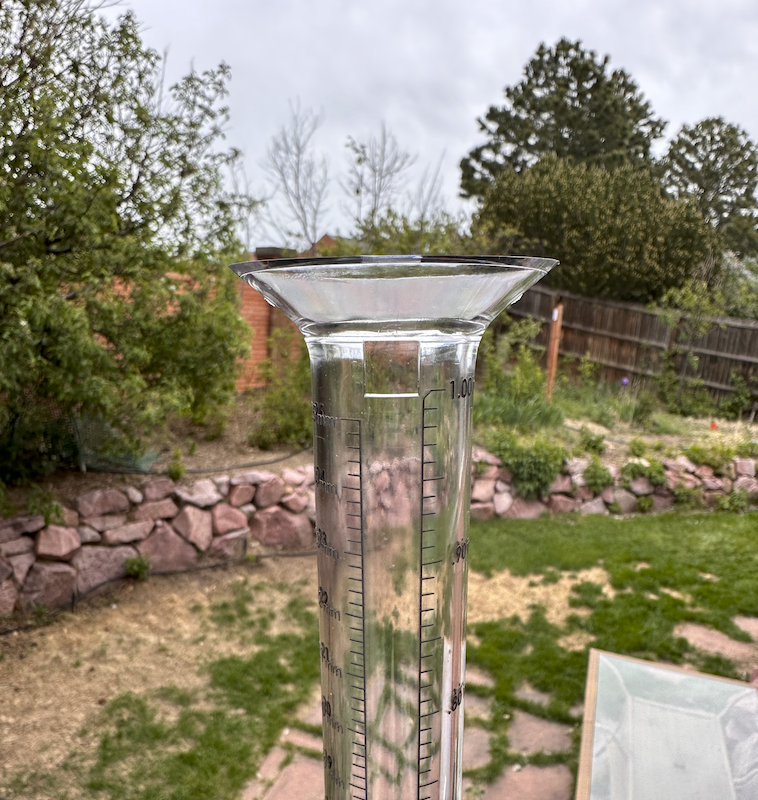
One very nice touch…Climalytics includes an extra-long bottle brush to help you remove the accumulated grime that inevitably settles in the bottom of the inner tube. The brush also allowed me to give a long overdue cleaning of the inner tubes of both my Stratus rain gauges. It was much appreciated.
Funnel
The funnels on both the Stratus and the Tropo are easy to remove and replace. The funnel on the Tropo is 1.75” taller that the Stratus’ to minimize splash-out and splash-in. Because of concern that the Tropo’s funnel might blow off, beads are molded into the exterior of the outer tube that fit into depressions on the inside of the funnel’s base to “lock” it into place. While this makes the Tropo’s funnel a little harder to remove, I’ve found light thumb pressure at the spout does the trick. The pour spout also ensures correct alignment when placing the funnel.
The Tropo comes with eight bird spikes that fit securely into ribs on the outside surface of the funnel. This adds roughly 2.5” to the overall height of the gauge.
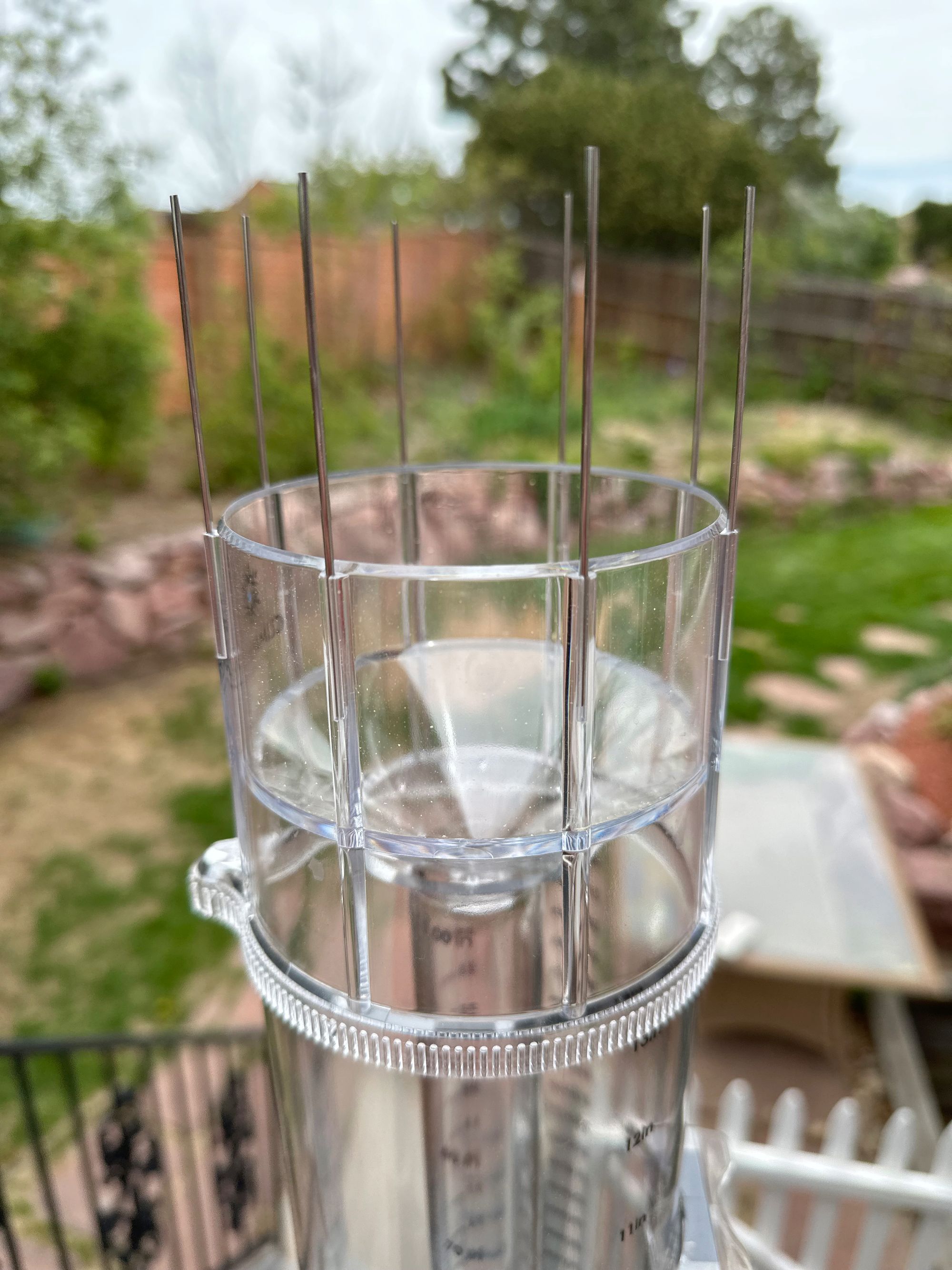
Conclusion
For weather observers desiring a rain gauge that’s easier to read with a few more nice features than those normally found, the Tropo is an excellent choice. It is well-constructed and comes complete with everything you need to mount it and begin observing. I’ve been using mine for two weeks during frequent thunderstorms. I’ve found no variance between the measurements of the two gauges; both agree within tolerances too hard to distinguish.
The Tropo is marketed as a premium rain gauge, and at an average price of $88 it certainly is compared with the $40 Stratus gauge. Both gauges are similar in accuracy and it boils down to how many features you’re willing to pay for. If you live in a hurricane-prone region or in the northwest or southeast where extensive downpours are a frequent occurrence, the Tropo is a good bet. If you live in an area with relatively deep snowfalls, the Tropo again has the edge in being able to extract a deeper snow core for snow water equivalent calculations. For the rest of us, the Stratus is an excellent and economical choice.
I purchased my Tropo the same day I was introduced to it at a CoCoRaHS conference in Estes Park, Colorado, and haven’t looked back. I have both the Tropo and the Stratus mounted on opposite sides of the same post and I’m logging the measurements of each, along with any differences, for the next year.
The Stratus is available from weatheryourway.com or from Amazon for around $40. The Tropo is available from Weather Your Way and can also be ordered directly from Climalytic.
If you’re an observer who wants accuracy and nice features, you can’t do better than the Tropo. If money is tight, the Stratus is a reliable yeoman CoCoRaHS gauge that will give you the same accuracy with fewer features for about half the price.
You can’t go wrong either way.
